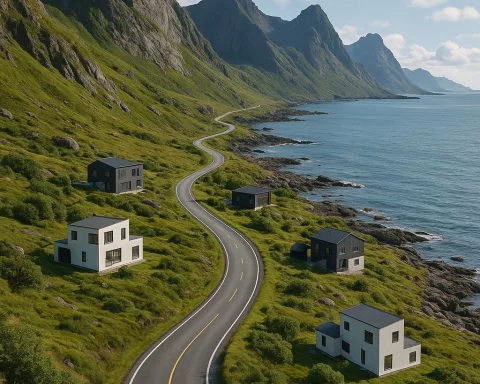The State of the Nation Address (SONA) in South Africa is a key moment for the country, where leaders reflect on successes and challenges, while outlining future plans. Minister Ramokgopa emphasizes the importance of unity and economic growth, calling for everyone to work together for a brighter future. He recalls the Freedom Charter, a historic document promoting equality, as a guiding light for collaboration among different political groups. Addressing the economy, he sets ambitious growth goals and focuses on improving infrastructure to boost development. Overall, Ramokgopa’s message is one of hope and determination, urging South Africans to stand united for progress.
What is the significance of the State of the Nation Address in South Africa?
The State of the Nation Address (SONA) is crucial for reflecting on South Africa’s political and economic landscape. It highlights past achievements, acknowledges challenges, and outlines future goals. Minister Ramokgopa emphasizes unity, infrastructure development, and economic growth while promoting collaboration across political factions.
In the dynamic world of South African politics, few events hold as much significance as the State of the Nation Address (SONA). This annual occasion offers a platform not only to reflect on past accomplishments and challenges but also to chart the course for the nation’s future. Minister Kgosientsho Ramokgopa, in his recent address, offers a compelling vision that interweaves policy, ideology, and governance, painting a vivid picture of South Africa’s path forward.
Revisiting the Freedom Charter
Minister Ramokgopa surprises many by invoking the Freedom Charter, a foundational document that has shaped South Africa’s socio-political landscape since the mid-20th century. His recognition of the Charter’s significance is particularly noteworthy, given its historical context as a manifesto for equality and democracy. This acknowledgment symbolizes a moment of unity among diverse political factions in envisioning South Africa’s future.
The Freedom Charter acts as a beacon, guiding national dialogue and encouraging diverse political entities to engage in discussions about the nation’s direction. Ramokgopa highlights how this document can serve as a unifying force, promoting collaboration across the political spectrum. His reference to this iconic manifesto underscores its enduring relevance in shaping the socio-political ethos of contemporary South Africa.
Ramokgopa’s nod to the Freedom Charter also reflects a broader understanding of its role in fostering national unity. By acknowledging its importance, he sets the stage for a more inclusive and collaborative approach to governance. This perspective encourages political leaders to come together, transcending ideological divides to work towards a shared vision for the country’s future.
Navigating Political Achievements and Setbacks
Minister Ramokgopa transitions to addressing the achievements and challenges faced by the African National Congress (ANC). Drawing on insights from Honourable Dr. Hlophe, he delves into the complexities of attributing successes and failures to individuals or the organization itself. Dr. Hlophe’s analysis of the period from 2009 to 2019 suggests that successes were often seen as personal triumphs, while failures were attributed to party structures.
Ramokgopa challenges this viewpoint, emphasizing the interconnected nature of leadership and organizational dynamics. He draws parallels to historical debates during the Renaissance about individual genius versus collective endeavor, illustrating the intricate relationship between personal leadership and institutional success. This perspective encourages a more nuanced understanding of the ANC’s role in shaping the nation’s trajectory.
The minister’s critique extends to the political discourse surrounding Honourable Malema, where he identifies a common pitfall: the conflation of distinct yet related frameworks. He uses the National Development Plan (NDP) and the Medium-Term Development Plan (MTDP) as examples to illustrate the importance of conceptual clarity in policy discussions. This distinction is crucial for effective governance, much like differentiating between Romanticism and Impressionism in the realm of art history.
Addressing Economic Challenges
Ramokgopa candidly addresses the state of the nation’s economy, acknowledging challenges such as low economic growth rates. Despite these difficulties, he sets an ambitious growth target of 3%, based on empirical research from the Bureau of Economic Research. This goal reflects a commitment to surpass population growth and achieve sustainable development.
The minister emphasizes the importance of aligning economic growth with historical trajectories, drawing parallels to the intricate machinery of economic models. Just as each component must function harmoniously in a machine, the various elements of the economy must work together to produce desired outcomes. This analogy underscores the need for coordinated efforts to drive economic progress.
A key aspect of Ramokgopa’s agenda involves boosting infrastructural development through increased investment. He highlights the current stagnation in gross fixed capital formation, aiming to elevate it from 14.9% to 30% of GDP. Achieving this goal requires innovative financing instruments to attract private sector participation, reminiscent of the economic liberalization strategies that fueled the Industrial Revolution.
Reinforcing Infrastructure and Governance
In a compelling discussion on infrastructure, Ramokgopa outlines both the commercial and social dimensions of investments in water and electricity. He cites successful partnerships with private entities, such as the Lebalele Water-Users Association and the Vaal-Gamagara partnership, as examples of effective collaboration. Modernizing Eskom’s operations is essential for enhancing the electricity grid, drawing parallels to the transformative impact of electrification in early 20th-century societies.
Freight logistics also receive considerable attention, with Ramokgopa setting clear targets to increase capacity from 149 million tons annually to 250 million by 2030. Strategic corridor investments, such as the Northern Cape-Saldanha line for iron ore and manganese, reflect a focused approach to economic growth. These initiatives echo the great infrastructural projects of the past that revolutionized trade and connected continents.
Strengthening local government capacity, particularly in electricity and water provision, forms a vital part of Ramokgopa’s strategy. Initiatives in regions like Limpopo and the Free State illustrate a pragmatic approach to governance, reminiscent of grassroots empowerment movements seen globally. This focus on local governance underscores the importance of empowering communities to drive development from the ground up.
Countering Reactionary Forces
Ramokgopa concludes his address by confronting what he terms the “ultra-right lunatic fringe,” critiquing their attempts to derail national transformation through fearmongering and economic destabilization. He reaffirms his commitment to safeguarding democratic achievements, drawing parallels to historical struggles against reactionary forces that sought to undermine progressive change.
His resolve to protect the transformation project remains steadfast and irreversible, reflecting a dedication to advancing South Africa’s democratic principles. Ramokgopa’s words resonate with a call to action, urging citizens to stand united against attempts to hinder progress and to remain committed to building a better future for all.
In summary, Minister Ramokgopa’s address weaves a narrative of ambition, realism, and resilience. His insights offer a roadmap for South Africa’s journey, informed by historical lessons and contemporary challenges. Through this lens, the nation continues its path forward, driven by the enduring spirit of its people and a shared vision of progress and unity.
“`markdown
What is the State of the Nation Address (SONA) and why is it important?
The State of the Nation Address (SONA) is a significant annual event in South Africa where the leadership reflects on the country’s political and economic landscape. It summarizes past achievements, acknowledges current challenges, and outlines future goals. Minister Ramokgopa, in his address, emphasizes unity, infrastructure development, and economic growth, calling for collaboration across various political factions to create a better future.
How does the Freedom Charter play a role in the State of the Nation Address?
Minister Ramokgopa invokes the Freedom Charter as a historical document that promotes equality and democracy, serving as a guiding light for unity among diverse political groups. By referencing the Charter, he encourages national dialogue and collaboration across political divides, highlighting its ongoing relevance in shaping contemporary South Africa’s socio-political ethos.
What are the major economic challenges addressed in the SONA?
In his address, Minister Ramokgopa candidly discusses the low economic growth rates facing South Africa. He sets an ambitious growth target of 3% to surpass population growth, reflecting a commitment to sustainable development. He emphasizes the need for increased investment in infrastructure, aiming to elevate gross fixed capital formation from 14.9% to 30% of GDP.
What strategies does Ramokgopa propose for infrastructure development?
Ramokgopa outlines a vision for boosting infrastructure, which includes investments in water and electricity, as well as freight logistics. He cites successful partnerships with private entities and aims to modernize operations at Eskom to enhance the electricity grid. Strategic investments in freight logistics are set to increase capacity significantly by 2030, reflecting a focused approach to driving economic growth.
How does the government plan to address local governance challenges?
Strengthening local government capacity is a key component of Ramokgopa’s strategy, particularly in water and electricity provision. Initiatives in regions like Limpopo and the Free State aim to empower local communities for grassroots development, emphasizing the importance of effective local governance in driving national progress.
What stance does Minister Ramokgopa take against reactionary forces in South Africa?
In his address, Ramokgopa confronts what he refers to as the “ultra-right lunatic fringe,” criticizing their attempts to undermine national transformation through fearmongering. He reaffirms his commitment to protecting democratic achievements and encourages citizens to stand united against efforts that threaten progress, highlighting the importance of resilience in the face of opposition.
“`












